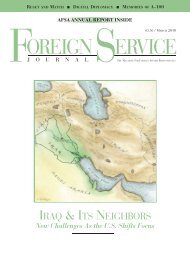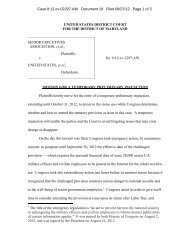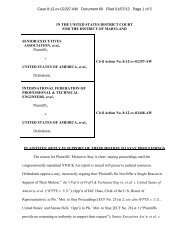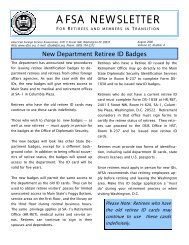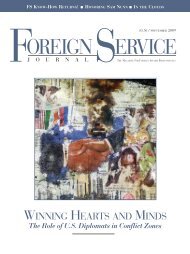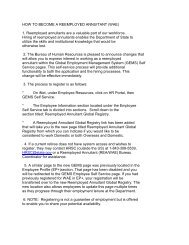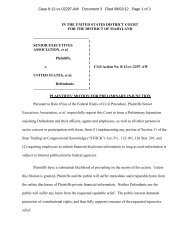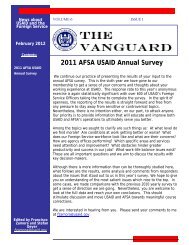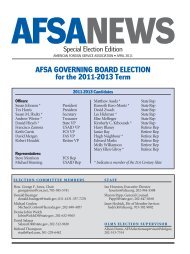F OCUS - American Foreign Service Association
F OCUS - American Foreign Service Association
F OCUS - American Foreign Service Association
You also want an ePaper? Increase the reach of your titles
YUMPU automatically turns print PDFs into web optimized ePapers that Google loves.
institutional memory, as well as the<br />
question of how well “quick-impact<br />
projects” fit into the framework of the<br />
Afghan National Development Strategy<br />
of 2006 and the broader Millennium<br />
Developments Goals.<br />
The ongoing insurgency in southern<br />
Afghanistan has taxed the will of a<br />
number of NATO members. This is<br />
especially the case in parliamentary<br />
systems where force deployments<br />
may enjoy the support of, at best, a<br />
fickle and fragile majority. Some of<br />
this opposition amounts to no more than knee-jerk anti-<br />
<strong>American</strong>ism, but in other cases it reflects a genuine conviction<br />
that military force cannot resolve the problems of<br />
Afghanistan. Others believe that the war is unwinnable<br />
because Afghan nationalism will always lead to successful<br />
popular mobilization against foreign forces. These convictions<br />
may be ill-grounded, but they are nonetheless<br />
part of the political environment with which the U.S. and<br />
its NATO allies must deal.<br />
The conflict in Iraq has complicated this problem.<br />
Deeply unpopular with European publics, it has the<br />
potential to drain support from the Afghan theater of<br />
operations, as well. In July 2007, White House Homeland<br />
Security Adviser Frances F. Townsend described the<br />
struggles in Iraq and Afghanistan as “clearly a single conflict<br />
by a single determined enemy who is looking for safe<br />
haven.” To European publics this is not a claim calculated<br />
to boost support for operations in Afghanistan; the<br />
most recent Transatlantic Trends survey, conducted by<br />
the German Marshall Fund of the United States in 2007,<br />
found that only 30 percent of European respondents supported<br />
combat operations against the Taliban in<br />
Afghanistan. A delinking of the two situations would help<br />
to make the case for sustaining the commitment more<br />
marketable.<br />
In a Feb. 8 interview, Secretary of Defense Robert<br />
Gates offered a nuanced defence of involvement in Afghanistan,<br />
noting that lingering anger in Europe over the<br />
U.S. invasion of Iraq explained why some allies were reluctant<br />
to heed U.S. calls for more combat troops in Afghanistan.<br />
It remains, however, to be seen how much the allies<br />
will deliver in response to the call for greater assistance to<br />
Afghanistan that was contained in the declaration of<br />
NATO members at the April 2008 Bucharest Summit.<br />
38 FOREIGN SERVICE JOURNAL/JULY-AUGUST 2008<br />
F <strong>OCUS</strong><br />
The ongoing<br />
insurgency in<br />
southern Afghanistan<br />
has taxed the will<br />
of a number of<br />
NATO members.<br />
Through Afghans’ Eyes<br />
NATO’s involvement is controversial<br />
not only in Europe, but in<br />
Afghanistan as well. Civilian casualties<br />
are one key problem. The arrival<br />
of international forces was celebrated<br />
in Afghanistan, where the Taliban<br />
remain deeply unloved. But any foreign<br />
force can outstay its welcome if it<br />
loses sight of the local population and<br />
its needs. Here, the problem of “collateral<br />
damage” is extremely serious.<br />
Every civilian casualty has the potential<br />
to create new enemies, and great care needs to be<br />
taken to avoid them if at all possible.<br />
Another weighty problem relates to the cultivation of<br />
opium poppies, an industry in which over two million<br />
Afghans are now entangled, many as poor wage-laborers.<br />
For the wider world, the temptation to deal with<br />
this problem through simple eradication may be considerable.<br />
But fear that this will happen is becoming a<br />
major recruiting tool for the Taliban, probably of<br />
greater significance to their insurgency than the cash<br />
that they may be able to derive from the drug trade.<br />
The issue of eradication has also become a point of<br />
friction between various NATO members and the government<br />
of Afghanistan. To some, the opium poppy is<br />
a curse which helps fund Taliban operations and should<br />
be eliminated with maximum expedition. To the Kabul<br />
government, this is profoundly naïve, given the number<br />
of poor Afghans who are dependent on some income<br />
from opium in order to eke out a meager living, and for<br />
whom “alternative livelihoods policies” remain a remote<br />
chimera. What has been largely lost in the dust surrounding<br />
this dispute is the complexity of the narcotics<br />
problem in Afghanistan, which is underpinned by<br />
diverse incentive structures, has multiple local variants,<br />
and is also significantly transnational in character.<br />
Dwarfing these issues, however, is the threat posed<br />
by the Taliban’s external sanctuaries. As a threat to<br />
Afghanistan’s stability, this is vastly more serious than<br />
the occasional cache of arms of Iranian origin. In<br />
August 2007, Pakistani President Pervez Musharraf<br />
made a very candid statement about this problem while<br />
addressing a so-called “Peace Jirga” in Kabul: “There is<br />
no doubt Afghan militants are supported from Pakistani<br />
soil. The problem that you have in your region is



